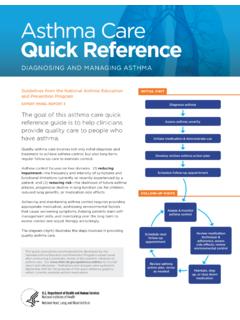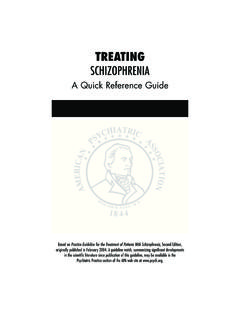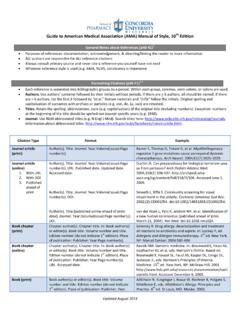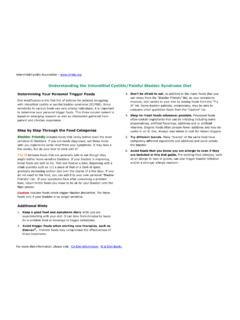Transcription of Quick Guide: Commissioning for transition to adult ...
1 Quick guide : Guidance for health services for children and young people with special educational needs and disability (SEND)NHS England Information Reader BoxDirectorateNursing Publications Gateway reference :06209 Document purposeGuidance Document nameQuick guide Health services for children and young people with special educational needs and DisabilityAuthorNHS England Publication date12 July 2018 Target audienceCCG Clinical Leaders, CCG Accountable Officers, CSU Managing Directors, Care Trust CEs, Foundation Trust CEs , Medical Directors, Directors of PH, Directors of Nursing, Local Authority CEs, Directors of adult SSs, NHS Trust Board Chairs, NHS England Regional Directors, NHS England Directors of Commissioning Operations, Allied Health Professionals, GPs, Communications Leads, Directors of Children's Services.
2 NHS Trust CEs Additional circulation listN/A DescriptionThis Quick guide aims to give health commissioners and providers of services a Quick resource to support services for children and young people with special educational needs and disability (SEND), introduced by Part 3 of the Children and Families Act 2014. Cross referenceQuick guide : Commissioning for transition to adult services for young people with special educational needs and disability (SEND)Superseded docs (if applicable)N/AAction requiredN/ATiming / deadlines (if applicable)N/AContact details for further informationNursing & Midwifery Skipton House 80 London Road London SE1 6LH Document StatusThis is a controlled document. Whilst this document may be printed, the electronic version posted on the intranet is the controlled copy.
3 Any printed copies of this document are not controlled. As a controlled document, this document should not be saved onto local or network drives but should always be accessed from the intranet. 3 Quick guide : Guidance for health services for children and young people with special educational needs and disability (SEND) Quick guide Health services for children and young people with special educational needs and disability (SEND)Version number: 7 First published: 12 July 2018 Prepared by: The Children with Complex needs / special educational needs and disability (CCN SEND) : OFFICIAL Equality and Health Inequalities statement Promoting equality and addressing health inequalities are at the heart of NHS England s values. Throughout the development of the policies and processes cited in this document, we have: considered the need to eliminate discrimination, harassment and victimisation, to advance equality of opportunity, and to foster good relations between people who share a relevant protected characteristic (as cited under the Equality Act 2010) and those who do not share it; and considered the need to reduce inequalities between patients in access to, and outcomes from, healthcare services, and to ensure that services are provided in an integrated way where this might reduce health NHS England s Equality and health inequalities legal duties guidance for more information.
4 4 Quick guide : Guidance for health services for children and young people with special educational needs and disability (SEND)Contents1 Introduction Working with schools and colleges 72 Statutory framework Joint Commissioning Local leadership and partnership working 83 Clinical Commissioning Group role 94 Designated Medical Officer or Clinical Officer role Overview of the role Local considerations re strategic and operational functions Additional support for designated officer roles 135 Education, Health and Care plan 136 Health contribution Early identification The beginning of the EHC plan process Requesting advice if known to services Requesting advice if not known to services Monitoring of the timescale and health role Timescales and exceptions Working with other professionals around the child and family Mental health Health visiting and nursing 177 Engaging with families Supporting and involving children and young people Opportunities to involve parents/carers Examples of working in partnership with parents Information, Advice and Support Services Complaints Mediation and first tier tribunal trial 205 Quick guide .
5 Guidance for health services for children and young people with special educational needs and disability (SEND)8 Data sharing Patient Communication and Engagement Processes and Governance Security 229 Children s and young people s health data set 2310 Patient Choice 2411 Annex A: Process for requests where the child is not known to clinicians 266 Quick guide : Guidance for health services for children and young people with special educational needs and disability (SEND)1 IntroductionThis Quick guide aims to help health commissioners and providers tackle the challenges involved in implementing the joint Commissioning of services for children and young people with special educational needs and disability (SEND) introduced by Part 3 of the Children and Families Act 2014.
6 It works in conjunction with the following existing national guidance: Department of Health (DH) 2016 SEND resources for Healthcare Professionals guide SEND code of practice: 0 to 25 years The guide should be read in parallel with the NHS England Quick guide Commissioning transition to adult services for young people with special educational needs and disability (SEND) and the Children and young people : Quick guide about personal health budgets and Integrated Personal of school children have an identified special educational need. A child or young person has SEND if they have a learning difficulty or disability which calls for special educational provision. A child of compulsory school age, or a young person, has a learning difficulty or disability if they: have a significantly greater difficulty in learning than the majority of others of the same age, or have a disability which prevents or hinders them from making use of facilities of a kind generally provided for others of the same age in mainstream schools or mainstream post-16 provision.
7 A child under compulsory school age has a learning difficulty or disability if they are likely to be within the above categories (or would be likely to be if no special educational needs provision was made). special educational needs can result from: a long-term condition or life-limiting condition, such as Duchenne muscular dystrophy a congenital condition, such as cerebral palsy a learning disability autistic spectrum disorder, including both autism and Asperger syndrome serious illness or injury, such as acquired brain injury a sensory impairment behavioural issues. 7 Quick guide : Guidance for health services for children and young people with special educational needs and disability (SEND)Many children and young people who have special Education needs (SEN) may have a disability .
8 disability is described under the Equality Act 2010 as a physical or mental impairment which has a substantial and long-term adverse effect on a person s ability to carry out normal day-to-day activities1. Local Clinical Commissioning Groups (CCGs) will be involved in the joint arrangements for the provision of care, enabling providers to access information via their commissioner, or via the Local Authority (LA). The LA will in some cases be the lead commissioner for children s services. Some information will also be published in the Local Offer section of the LA website, which should reflect the health services available to a child or young person with SEND in accordance with the Children and Families Act 2014 (Part 3 Information and Advice Section 30). Working with schools and colleges It is important that the health system works closely with the education system.
9 All maintained nursery schools, mainstream schools, free schools and academies must have a special educational needs Co-ordinator (SENCo). This postholder will be a key point of liaison for health child or young person s educational attainment can be affected by school absences due to hospitalisation, frequent appointments or lack of support to promote attendance. Schools and colleges can make their own valuable contribution by co- Commissioning appropriate health and social care, to ensure that seamless support is available to these Statutory framework The Children and Families Act 2014 introduced a number of new duties for CCGs to: commission services jointly for children and young people (up to age 25) with SEND, including those with Education Health and Care EHC plans work with the LA s to contribute to the Local Offer of services available ensure that health providers inform parents and the appropriate LA where they think that a young child under compulsory school age has, or probably has, SEN and/or a disability have mechanisms in place to ensure practitioners and clinicians will support the integrated EHC needs assessment process agree personal budgets, where they are provided for those with EHC plans.
10 1 Equality Act 2010, Part 2, Chapter 1, Section 68 Quick guide : Guidance for health services for children and young people with special educational needs and disability (SEND) Joint Commissioning Arrangements must be in place for considering and agreeing: what education, health and care provision is to be secured by whom education, health and care provision is to be secured what advice and information is to be provided about education, health and care provision by whom, to whom and how such advice and information is to be provided how complaints about education, health and care provision may be made and are to be dealt with procedures for ensuring that disputes between the parties to the joint Commissioning arrangements are resolved as quickly as Commissioning arrangements for securing education, health and care provision must in particular include arrangements for.
















